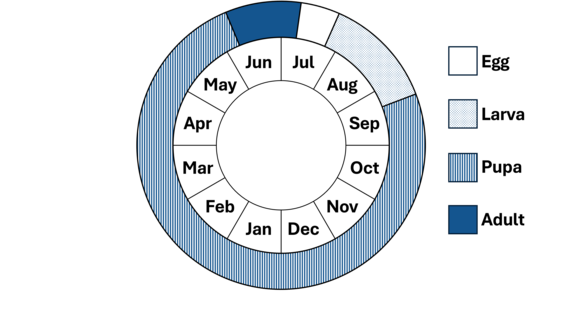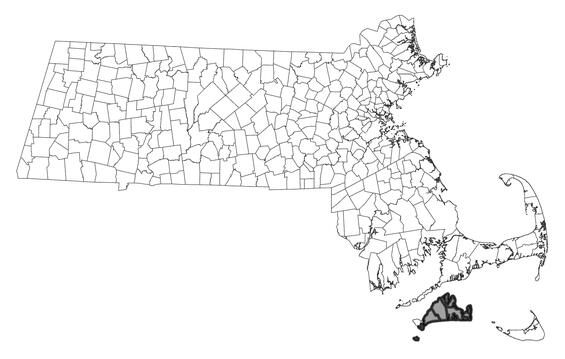- Scientific name: Stenoporpia polygrammaria
- Species of Greatest Conservation Need (MA State Wildlife Action Plan)
- Threatened (MA Endangered Species Act)
Description

Faded gray geometer (Stenoporpia polygrammaria)
The faded gray (Stenoporpia polygrammaria) is a geometrid moth with a wingspan of 30-40 mm (1.2-1.3 in) (Forbes 1948, McGuffin 1977). Both the forewing and the hind wing have a pale, whitish-gray ground color, peppered with dark gray and brownish-gray scales. The outer margin of the forewing is scalloped with a black to brownish-black terminal line. The forewing subterminal line is white and scalloped, sometimes obscure; shading between the postmedial and subterminal lines is typically more pale than distal to the subterminal line. The postmedial, median, and antemedial lines of the forewing are relatively smoothly curved, black to brownish-black in color. The postmedial and median lines are widely spaced at the costal margin, curving outward and then sharply inward in the vicinity of the radial veins, becoming relatively straight and closely parallel and extending to the inner margin; the two lines are typically connected by a concolorous patch of scales at the intersection of veins Cu1 and M3 at the outer edge of the discal cell. The postmedial line is bordered distally with a narrow band of brown scales, especially toward the inner margin. The antemedial line is double, and like the postmedial and median lines, widely spaced at the costal margin, curving outward and then inward to become closely parallel, extending to the inner margin and outlining an oval area in the basal portion of the wing. Like the forewing, the outer margin of the hind wing is scalloped with a black to brownish-black terminal line. Also like the forewing, the hind wing has a white, scalloped, sometimes obscure subterminal line, with shading between the postmedial and subterminal lines typically more pale than distal to the subterminal line. The hind wing has black to brownish-black, shallowly-curved postmedial and median lines, the former bordered distally with a narrow band of brown scales. A discal spot is present, concolorous with the postmedial and median lines. The wing fringes are white. The head, thorax, and abdomen match the pale, whitish-gray ground color of the wings, and are similarly peppered with dark gray and brownish-gray scales; additionally, the abdomen has black to brownish-black bands. Superficially, the faded gray resembles the common gray (Anavitrinella pampinaria), but the latter is on average smaller and darker; details of the description and the image here should suffice to separate the two.
Life cycle and behavior

In Massachusetts, adult faded gray moths fly from early June through the beginning of July. Larvae feed on oaks (Quercus spp.), becoming fully grown by August or early September. The pupa overwinters.
Distribution and abundance
The faded gray geometer ranges from Maine south to Georgia, and west to Saskatchewan and Arkansas (Forbes 1948, McGuffin 1977, Wagner et al. 2001). It is rare and locally distributed throughout much of its range. In Massachusetts, this species is only known to occur on Martha’s Vineyard.

Distribution in Massachusetts from 2000-2025 based on records in the Natural Heritage Database.
Habitat
In Massachusetts, the faded gray geometer inhabits coastal pitch pine-scrub oak barrens and scrub oak thickets, as well as open oak woodland.
Healthy habitats are vital for supporting native wildlife and plants. Explore habitats and learn about conservation and restoration in Massachusetts.

Coastal pitch pine-scrub oak barrens with scattered oak trees, ideal habitat for the faded gray geometer. Habitat managed by TNC at Medicine Lots Preserve.
Threats
The faded gray geometer is threatened by habitat loss and fire suppression in its disturbance-dependent habitats, in particular pitch pine-scrub oak barrens and oak woodland. Other potential threats include introduced generalist parasitoids, aerial insecticide spraying, non-target herbicide application, and off-road vehicles. The effect of a warming climate may not be detrimental to this species in Massachusetts; its range extends south to Georgia, suggesting adaptation to warm temperatures.
Conservation
Land protection and habitat management are the primary conservation needs of this species in Massachusetts. In particular, coastal pitch pine-scrub oak barrens and open oak woodland should be conserved, restored, and managed to maintain habitat for this species and the entire suite of rare and threatened species dependent on such habitats.
Survey and monitoring
The distribution of the faded gray geometer in coastal pitch pine-scrub oak barrens and open oak woodland on Martha’s Vineyard is well documented. Known populations of this species should be surveyed to document persistence at least once every 25 years; every 10 years is more desirable when practicable.
Management
Management of coastal pitch pine-scrub oak barrens and open oak woodland benefits a suite of rare and threatened species, and habitat condition should be monitored and management adapted as needed. For the faded gray geometer, barrens and open-canopy woodland with abundant shrub and tree oaks (Quercus spp.) is of particular importance.
Research needs
The natural history and conservation needs of the faded gray geometer are relatively well known. However, as with other species with a geographic range mostly south of Massachusetts, the future effects of a warming climate on this species are unpredictable and should be documented.
References
Forbes, W.T.M. 1948. Lepidoptera of New York and Neighboring States. Part II. Memoir 274, Cornell University Agricultural Experiment Station, Ithaca, New York. 263 pp.
McGuffin, W.C. 1977. Guide to the Geometridae of Canada (Lepidoptera). Volume II. Subfamily Ennominae, part 2. Memoirs of the Entomological Society of Canada No. 101: 1-191.
Wagner, D.L., D.C. Ferguson, T.L. McCabe, and R.C. Reardon. 2001. Geometroid Caterpillars of Northeastern and Appalachian Forests. Forest Service, U.S. Dept. of Agriculture, Washington, DC. 239 pp.
Contact
| Date published: | March 6, 2025 |
|---|